Process of designing
A black woollen suit, denim trousers and a jacket, a trench-coat, white shirt,
pencil skirt, and a little black dress are items that I chose to re-design according
to my rst memories of them and a collection of sculptures of a piece of cloth.
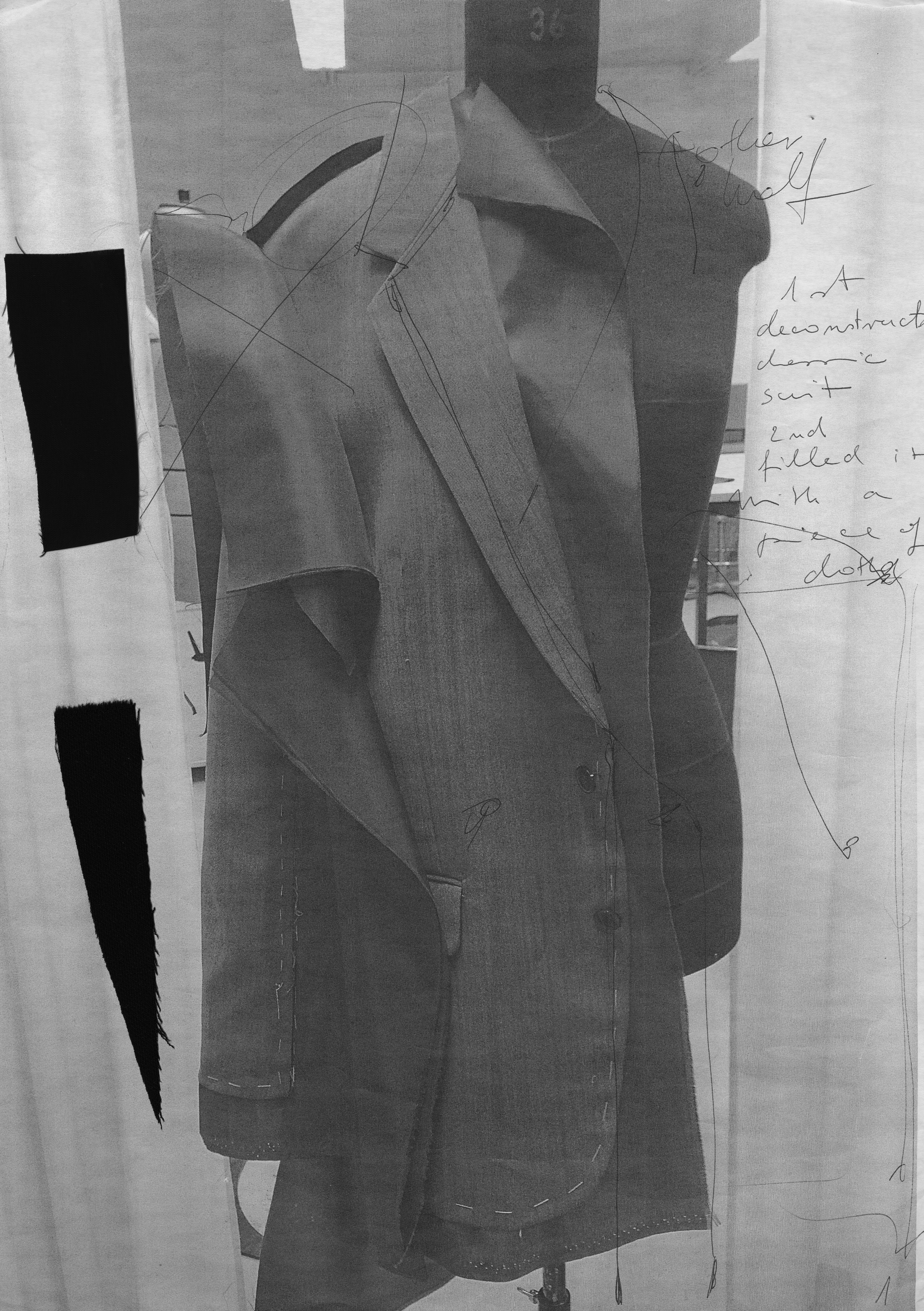

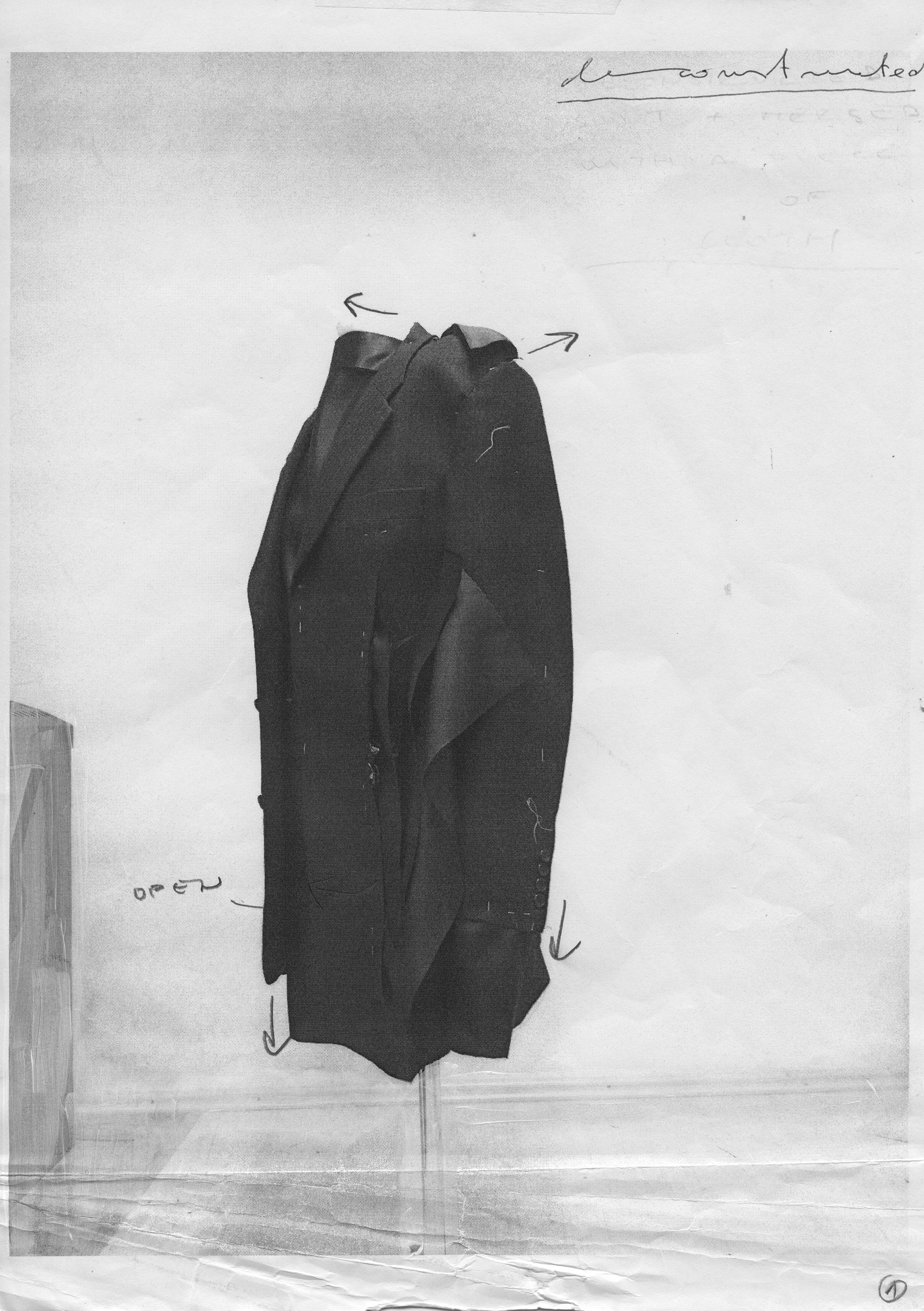
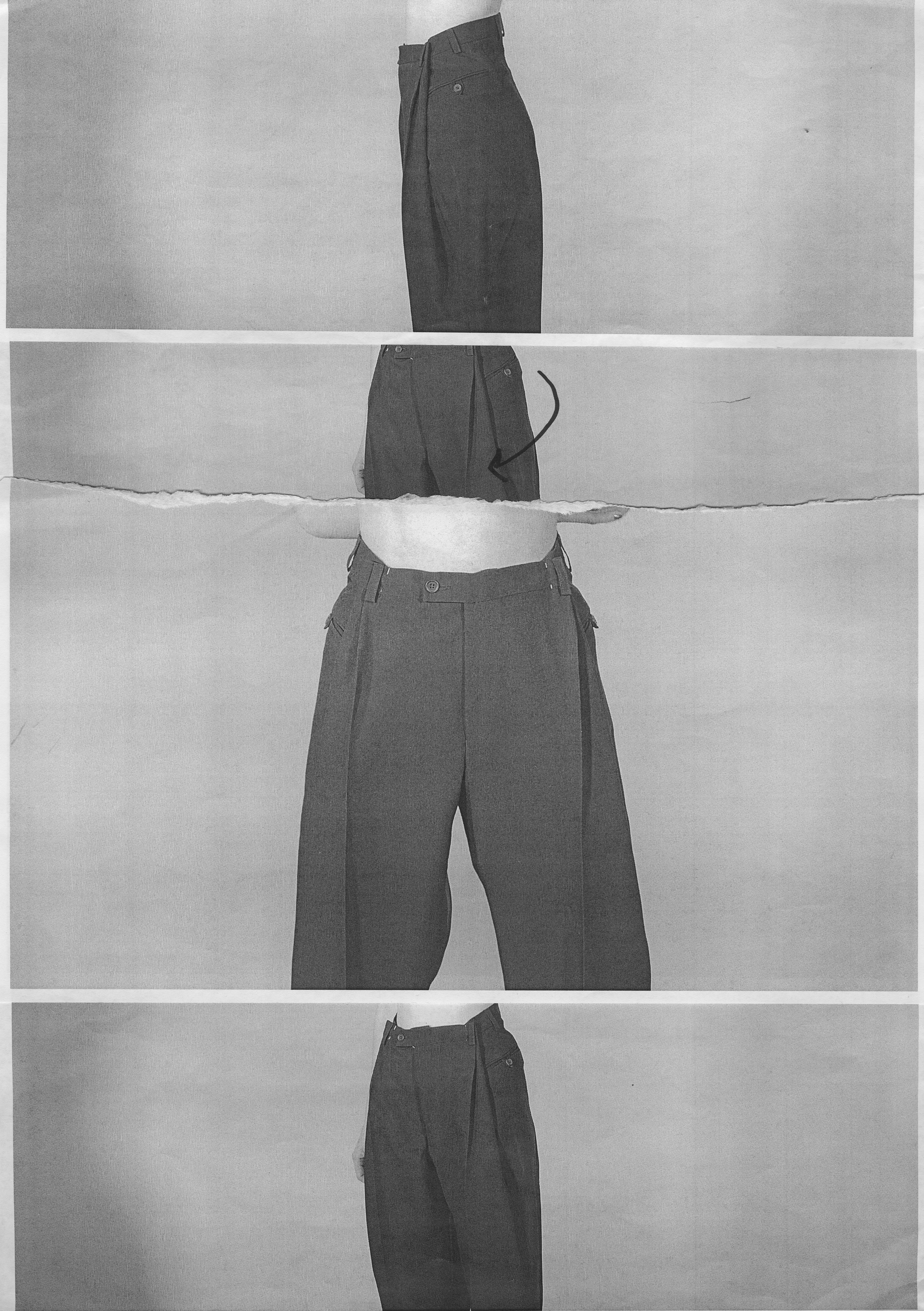


A black woolen suit
A suit is created out of a men’s pattern, size 56. Although pattern base is men’s, it's closing was designed as women’s and a chest pocket was relocated to the right side. Such elements were chosen to neutralize masculine look of the garment. I created two variations of an oversized suit, one single and another one double-breasted, both with a narrow lapel. Wool that I chose was black and was winter heavy. The decision for selecting thicker wool instead of thinner came from an inspiration of thick cotton paper sculptures which this collection was partially inspired by. The fixation with the sculptures’ particular volume is evident throughout my collection of re-designed classic garments. A way in which I interpreted a piece of cloth in a pair of suits, was by deconstructing a suit and merging it with a piece of cloth. First, I opened the suit at its side seams and darts, second I covered it with a piece of cloth and finally started pulled the cloth through the opened seams and darts. I have been cutting and adjusting these visible parts of the cloth and finally created two different variations of it. A material used for it was a cupro underlining. The reason for choosing underlining at all was that it is a material naturally a part of a suit. I have created a separate pattern for the bits of underlining visible and inserted them in the base of an oversized woolen suit. I finished the inside with the same underlining. The parts of visible cupro underlining were bonded two times with a thin black fusible on the inside to achieve the desired volume. The pants were also men’s, oversized (56), black and woolen with a one-sided fold aiming towards the pockets. I fitted the pants, which created darts on both sides of the front starting at the front fold. The back of the pants, when fitted to a size 36, lifted to the middle of the back. Because of the curve that the back forms I have taken in the pants pattern according to it in the mid back. Furthermore, the back pockets reached the front. I created two styles of the oversized and fitted woolen pants.
![]()
![]()
A suit is created out of a men’s pattern, size 56. Although pattern base is men’s, it's closing was designed as women’s and a chest pocket was relocated to the right side. Such elements were chosen to neutralize masculine look of the garment. I created two variations of an oversized suit, one single and another one double-breasted, both with a narrow lapel. Wool that I chose was black and was winter heavy. The decision for selecting thicker wool instead of thinner came from an inspiration of thick cotton paper sculptures which this collection was partially inspired by. The fixation with the sculptures’ particular volume is evident throughout my collection of re-designed classic garments. A way in which I interpreted a piece of cloth in a pair of suits, was by deconstructing a suit and merging it with a piece of cloth. First, I opened the suit at its side seams and darts, second I covered it with a piece of cloth and finally started pulled the cloth through the opened seams and darts. I have been cutting and adjusting these visible parts of the cloth and finally created two different variations of it. A material used for it was a cupro underlining. The reason for choosing underlining at all was that it is a material naturally a part of a suit. I have created a separate pattern for the bits of underlining visible and inserted them in the base of an oversized woolen suit. I finished the inside with the same underlining. The parts of visible cupro underlining were bonded two times with a thin black fusible on the inside to achieve the desired volume. The pants were also men’s, oversized (56), black and woolen with a one-sided fold aiming towards the pockets. I fitted the pants, which created darts on both sides of the front starting at the front fold. The back of the pants, when fitted to a size 36, lifted to the middle of the back. Because of the curve that the back forms I have taken in the pants pattern according to it in the mid back. Furthermore, the back pockets reached the front. I created two styles of the oversized and fitted woolen pants.






Denim jacket and trousers
I approached designing of a denim jacket with the same inspiration as other wardrobe items only with a different approach to it. For the first version of a denim jacket, I created a handkerchief inspired jacket. I opened the side seams of a jacket, spread it flat over a square-shaped cloth matching the edges of a jacket with that of a primary form. The base for a trucker jacket was men’s 56, however, the closing of it was created as women’s. I kept most of the details of a classic denim jacket intact only modifying its shape. For the second version of a jacket, I turned an oversized men’s jacket inside out, fitting it to a women’s size 36. I created a women’s closing and an asymmetric and smaller fit of a jacket by folding the buttoned side of the placket. The pants were size 56 and fitted to women’s 36 from the waist to the knees on one side, and to the mid-thighs on the other. The jeans were cut open from the bottom to the end of the darts to simulate a piece of cloth. The material used was an indigo colored, raw cotton denim of a high thickness. For the second version of a denim outfit, denim was used with it's inside out on the denim trousers, complementing a similarly designed denim jacket.




Trench coat, a white shirt, and a pencil skirt
A trench-coat size 56 is a replica of the one found at a recycling center for the purposes of prototyping. What I changed was for it to have a women’s closing and a flap on the right side instead of left. I wished to approach it's re-designing according to my inspirations, however from a different angle than before. I have achieved a feeling of a piece of cloth by cutting into it instead of adding a material to it. What I did is, cut the cut open above the vent in the mid back towards the side seams of a coat. A vent was able to be buttoned. When unbuttoned the two sides of the lower back of the trench-coat would open and give a feeling of the extra material. Through this opening, the elongated back of a white shirt would then show. A white cotton poplin shirt with an elongated back was created from the same pattern base as other garments in the collection. Its form was directly inspired by the silhouettes of sculptures. It's details such as closing and a chest pocket were all women’s. Meaning that the pocket was on the right side of the chest. On it, I used a starch when ironing to achieve a volume as suggested by the cotton paper sculptures. A skirt was a classic black woolen pencil skirt with a vent. However, it was oversized and fitted on one side of the hip. The access material created a fold on the side. The skirt was also designed back to front, therefore it’s back vent showed on front. A material used for a skirt was black wool, same as used for a couple of suits. Also, it had relocated seams.
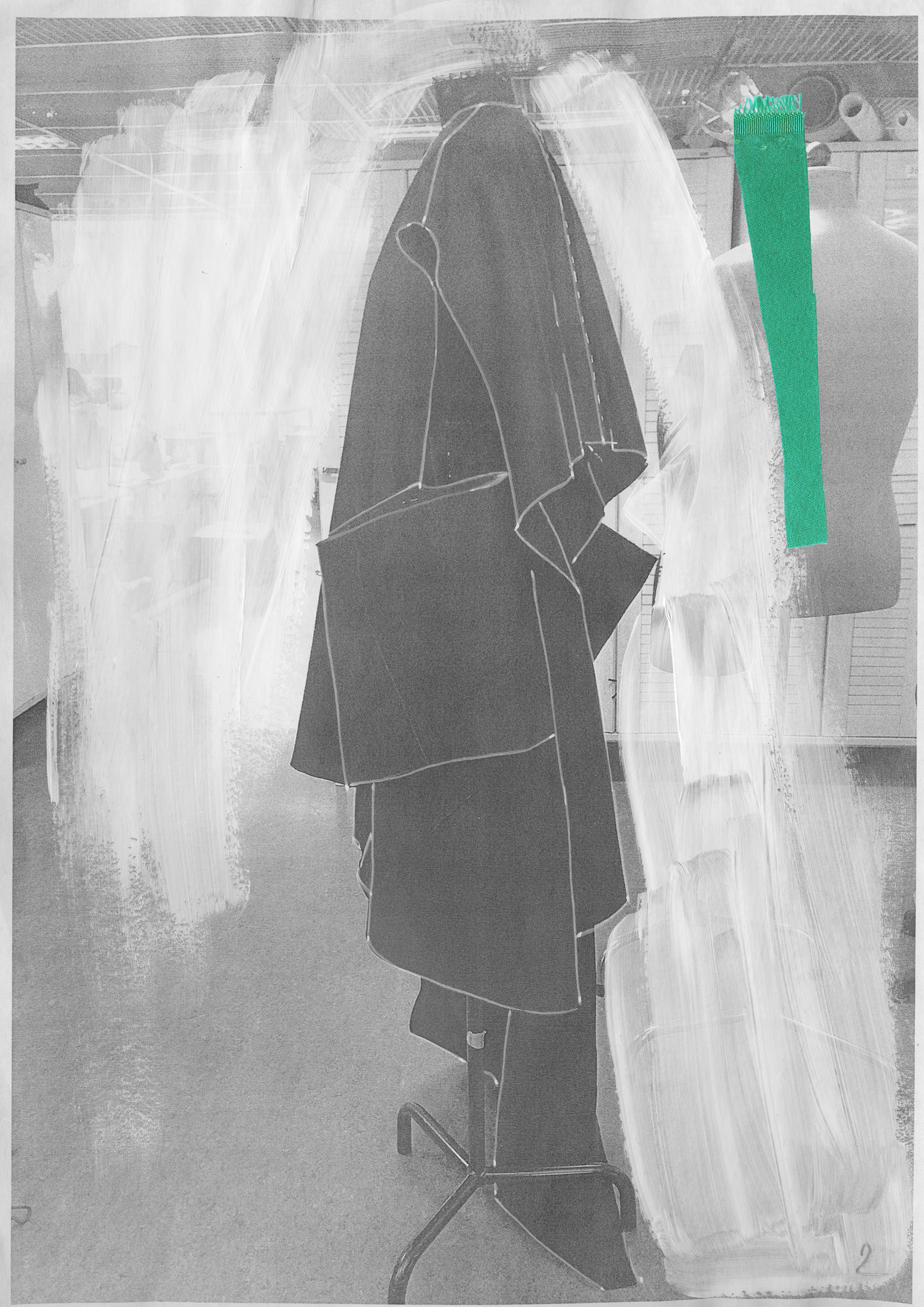
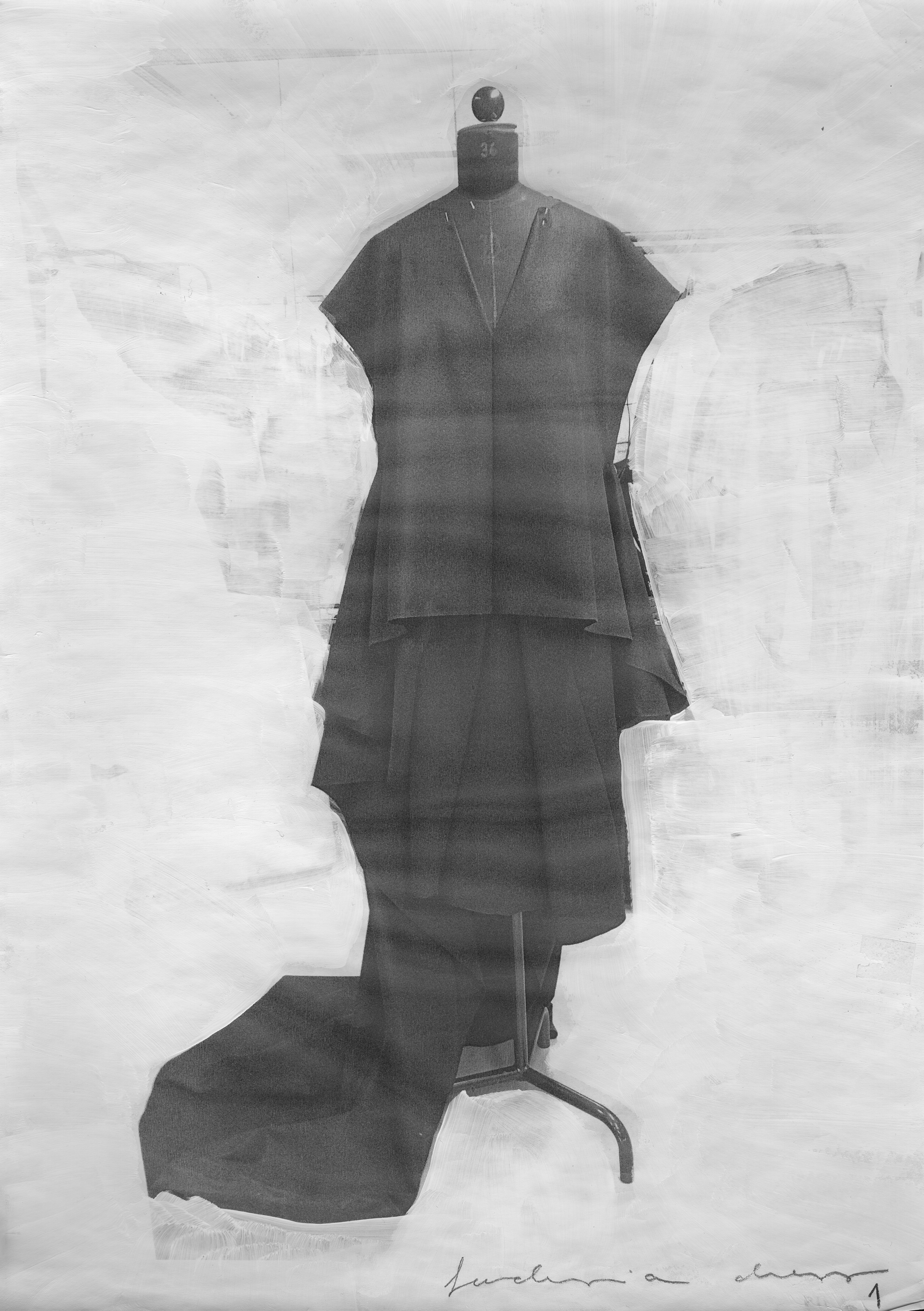
A dress
Two dresses are based on a men’s pattern size 56. They consist of a top and bottom, which is a skirt. A skirt is oversized and fitted on one side of one hip. Side seams of the skirt are moved to create a seam-detail in front and an asymmetric feel. A top is a literal translation of a collection of sculptures into a garment. The top is, therefore, a tailored piece of cloth. While it's pattern base is very much oversized, a top is fitted in the front and back and has side seams. A color magenta and emerald green derive from a coloring exercise and the memory of my grandmother’s pink and green satin gowns. Colors were chosen and interpreted brighter to create what I thought was a more contemporary shade. A 100% silk satin was selected to which I furthermore added brightness with two layers of a thin white fusible. The effect that this also gave was a certain thickness resembling the sculptures of cloth from which the dresses derive. A black woollen suit, denim trousers and a jacket, a trench-coat, white shirt, pencil skirt, and a little black dress are items that I chose to re-design according to my rst memories of them and a collection of sculptures of a piece of cloth.
2017